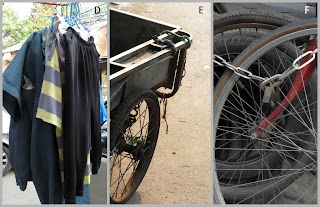Like any other country, the first hazing foreigners receive starts with the food. Located at a shopping center next to NCUT, the very first restaurant that my fellow grad students and I went to along with our newly acquired Chinese friends showed us what real spicy food taste like. Printed on their menus are these four different spicy levels: using one pepper as less spicy and four peppers as the spiciest. The middle picture shown on the right sums up what a 4 pepper-level food looks like. Literally half of the wok was filled with peppers. One thing for sure happened after the dinner, our sinuses cleared up and several of us had few trips to the toilet.
 It didn't take that long for me to try out one of their bizarre street food. On my first night in China I ate couple scorpions at Wangfujing, one of the most vibrant shopping streets in Beijing. The scorpions were fried, of course, or else I wouldn't have done it.
It didn't take that long for me to try out one of their bizarre street food. On my first night in China I ate couple scorpions at Wangfujing, one of the most vibrant shopping streets in Beijing. The scorpions were fried, of course, or else I wouldn't have done it.  The streets of Beijing and other urban cities all throughout the country provide the cheapest belly-filler food you can find. Most of these street side restaurants are specialized on one type of food - whether it's noodles, dumplings, skewers or something else. Of course, our Chinese friends made sure that we get to eat at several types of these restaurants. These restaurants might not have the decor and furnishing one would hope for, but there is something about sitting out there next to busy streets that made the whole experience a lot more enjoyable and homey than the restaurants at the mall. There is nothing more satisfying than having few beers and skewers with your friends at one of these street side restaurants - I suspect that locals feel the same way. But as more and more developments turn local streets into huge commercial areas these street side restaurants are now starting to dwindle.
The streets of Beijing and other urban cities all throughout the country provide the cheapest belly-filler food you can find. Most of these street side restaurants are specialized on one type of food - whether it's noodles, dumplings, skewers or something else. Of course, our Chinese friends made sure that we get to eat at several types of these restaurants. These restaurants might not have the decor and furnishing one would hope for, but there is something about sitting out there next to busy streets that made the whole experience a lot more enjoyable and homey than the restaurants at the mall. There is nothing more satisfying than having few beers and skewers with your friends at one of these street side restaurants - I suspect that locals feel the same way. But as more and more developments turn local streets into huge commercial areas these street side restaurants are now starting to dwindle.


















